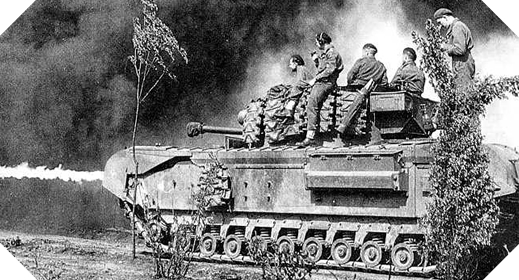Mark IV Churchill Crocodile tank
History, technical sheet and photo

Mark IV Churchill Crocodile tank history
The chassis of the British Churchill tank, as well as that of the American Sherman, serves as the basic structure for many other versions (flamethrowers, anti-mines, bridges …) used by the British forces during the Normandy landings and better known as “funnies”. These engines, devised by the English general Percy Hobart, must improve the capabilities of crossing and support fire to the benefit of Allied land forces.
In 1943, the British military engineers developed the flamethrower model of the Churchill tank, called Crocodile, capable of producing a flame that springs about ten meters in line with the vehicle. These flames allow the Allies to destroy enemy shelters and bunkers without necessarily appealing to the demolition teams of the infantry.
The first unit to be equipped with the Churchill Crocodile is the 141st Royal Armored Corps, shortly after the Normandy landing.
Mark IV Churchill Crocodile tank specification
Creator/User: Britain
Denomination: Mark IV Churchill Crocodile tank
Length: 7,65 m
Width: 3,25 m
Height: 2,45 m
Weight: 39,600 kg
Maximum speed: 27 km/h
Operational range: 144 km
Engine: Bedford horizontally opposed twin-six petrol engine 350 hp, 261 kW, 2,200 rpm
Consumption: 334 liters per 100 kilometers
Crew: 5 (commander, gunner, loader/radio operator, driver, co-driver/hull gunner)
Main armament: one 75 mm (6 Pounder) Mk III ROQF gun
Secondary armament: two 7,92 mm Besa machine guns and one flamethrower
Front armor: 152 mm
Rear armor: 35 mm
Specialty: flamethrower tank
![]() Back to the Battle of Normandy tanks
Back to the Battle of Normandy tanks




